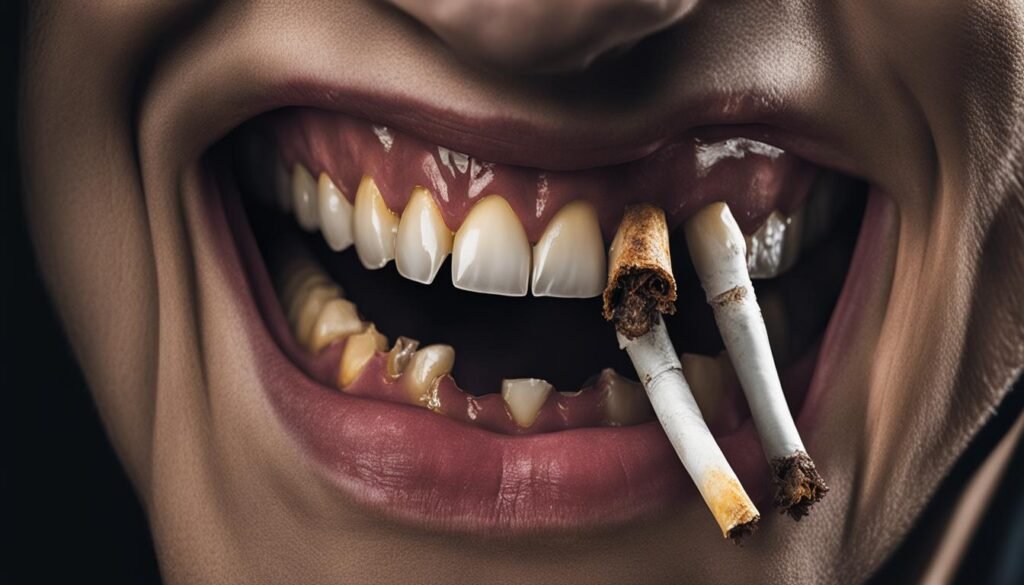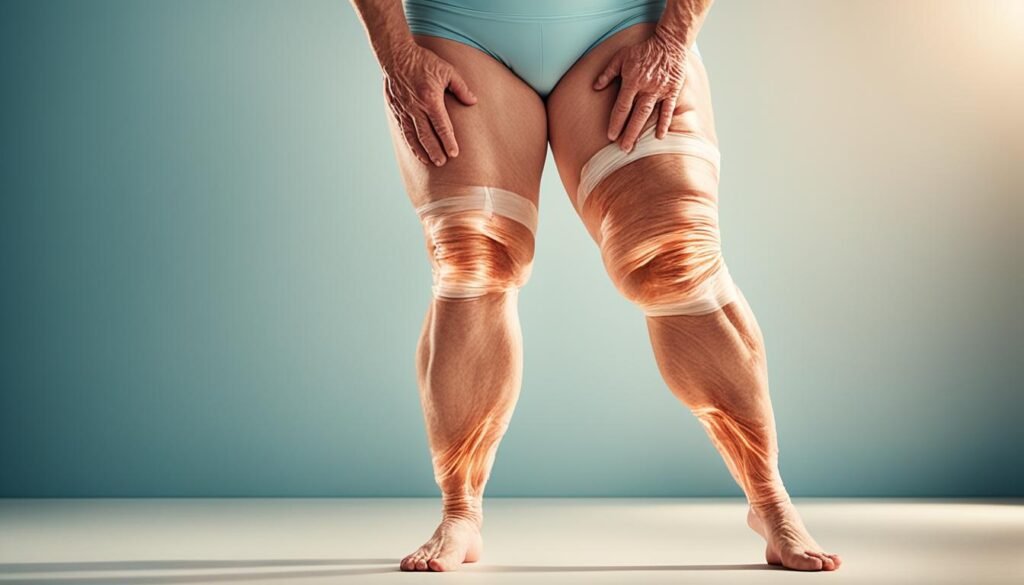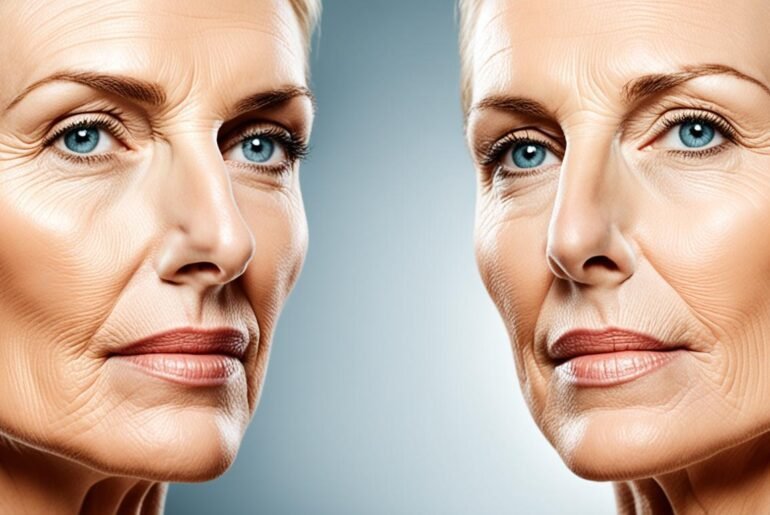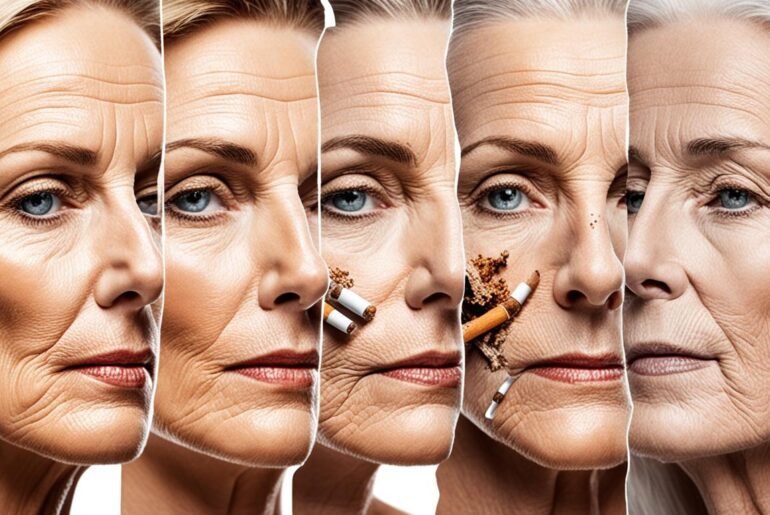Did you know that smoking accelerates the aging process of your skin? It’s true – smoking is a major contributor to premature aging, causing wrinkles and fine lines to appear much earlier than they would in non-smokers.
Key Takeaways:
- Smoking is a significant factor in skin aging, leading to premature wrinkles and fine lines.
- The chemicals in tobacco smoke have detrimental effects on the skin’s appearance and elasticity.
- Quitting smoking can help promote healthier and younger-looking skin.
- Smoking also affects wound healing, increases the risk of skin conditions, and has other negative impacts on oral health and body shape.
The Impact of Smoking on Skin Aging
Smoking has a significant impact on the aging process of the skin, leading to premature aging, wrinkles, and fine lines. Several studies have shown the negative effects of smoking on the skin (First source: 1, Second source: Introduction, Third source: Introduction).
The chemicals present in tobacco smoke, such as nicotine and reactive oxygen species, play a crucial role in disrupting the production of collagen, a protein responsible for maintaining the skin’s structure and elasticity. In addition, smoking increases the levels of matrix metalloproteinases (MMP), enzymes that break down the skin’s supporting structures (Second source: Introduction).
As a result of these chemical changes, the skin loses its firmness and elasticity, leading to the formation of wrinkles and fine lines. Smokers tend to exhibit more prominent signs of aging compared to non-smokers of similar age (Third source: Introduction). The impact of smoking on skin aging can make individuals look older than their non-smoking counterparts.
By understanding the detrimental effects of smoking on the skin, individuals can make informed decisions about their tobacco use and take steps to mitigate the impact on their skin health. Quitting smoking can help prevent premature aging and improve the overall appearance of the skin (Third source: Introduction).
Through smoking cessation, individuals can restore the health and vitality of their skin, reducing the visibility of wrinkles and fine lines. By prioritizing their skin health and avoiding tobacco use, individuals can maintain a more youthful appearance and promote long-term skin wellness.
The Relationship Between Smoking and Skin Conditions

Smoking has been associated with various skin conditions, including poor wound healing, acne, psoriasis, and hair loss. The harmful components of tobacco smoke can significantly impair the skin’s natural healing processes, leading to delayed wound healing and an increased risk of complications.
“Smoking not only harms the lungs but also has detrimental effects on the skin.”
Individuals who smoke are more likely to experience difficulties in the healing of wounds, such as surgical incisions or injuries. The toxicants present in tobacco smoke interfere with the normal cellular processes involved in wound repair, resulting in prolonged healing times and a higher risk of infection.
“The toxicants in tobacco smoke can exacerbate existing skin conditions and contribute to the development of new ones.”
Smoking has also been linked to the development or aggravation of acne, a common dermatological condition. The chemicals in tobacco smoke can clog the pores and increase sebum production, leading to the formation of acne lesions. Furthermore, smoking has been associated with psoriasis, an autoimmune disease characterized by red, scaly plaques on the skin. Studies have shown that smokers are more likely to develop psoriasis, and smoking can worsen the severity of existing cases.
“Smoking can have detrimental effects on scalp health and hair growth.”
Smoking has been found to be a risk factor for hair loss and scalp disorders. The toxins in tobacco smoke can decrease blood flow to the hair follicles, leading to reduced nutrient supply and impaired hair growth. Additionally, smoking has been associated with an increased prevalence of conditions such as alopecia areata and premature graying of hair.
| Skin Conditions | Impact of Smoking |
|---|---|
| Poor Wound Healing | Delayed healing, increased risk of complications |
| Acne | Increased risk and aggravation |
| Psoriasis | Higher risk and worsened severity |
| Hair Loss | Increased prevalence and impaired growth |
It is important to note that smoking can have significant negative effects on the health and appearance of the skin. Quitting smoking is an important step towards improving skin condition and overall well-being.
“The harmful effects of smoking on the skin should not be ignored. Quitting smoking can have a positive impact on skin health.”
Smoking and Skin Appearance
Smoking significantly affects the appearance of the skin. As a result of tobacco smoke exposure, smokers often develop facial wrinkling and sagging much earlier than non-smokers, resembling the skin of individuals in their 60s while still in their 40s. The harmful effects of smoking on the skin can lead to a grayish and wasted complexion, giving it a dull and unhealthy appearance.
The production of metalloproteinases (MMPs) caused by smoking breaks down collagen, a crucial protein responsible for maintaining skin elasticity and firmness. Consequently, smokers experience decreased skin resilience and increased sagging. Furthermore, smoking constricts blood vessels near the skin’s surface, leading to reduced blood flow, oxygen supply, and essential nutrients to the skin. This compromised circulation contributes to a grayish complexion and impaired skin health.
It is important to emphasize that these negative effects on skin appearance can be significantly diminished or even reversed by quitting smoking. By ceasing tobacco use, individuals can improve their skin’s overall health, firmness, and vitality, thus achieving a more youthful and radiant appearance.
Smoking and Wound Healing

Smoking has a detrimental effect on wound healing. The toxicants present in tobacco smoke impair the body’s natural healing processes, resulting in impaired healing and an increased risk of complications.
“The chemicals in tobacco smoke have been shown to negatively impact wound healing, leading to slower healing, increased risk of infection, and wound separation.” – Plastic Surgeon Dr. Smith
Before and after surgical procedures, smokers are more likely to experience delayed wound healing and complications such as infections and wound separation. The harmful components of tobacco smoke interfere with the body’s ability to repair and regenerate damaged tissues, prolonging the healing process.
Furthermore, the impaired healing associated with smoking can result in poorer cosmetic outcomes and increased scarring, affecting both physical appearance and psychological well-being.
To minimize these risks, plastic surgeons often advise patients to quit smoking before undergoing cosmetic surgeries. By quitting smoking, individuals can enhance their body’s natural healing mechanisms, reduce the risk of complications, and improve the overall outcome of surgical procedures.
Surgical Complications Associated with Smoking
Research indicates that smoking increases the risk of various surgical complications:
| Complication | Risk Increase |
|---|---|
| Wound infections | 1.5 to 3 times higher |
| Wound dehiscence | 2 to 2.5 times higher |
| Delayed wound healing | 2 to 5 times higher |
| Hematoma | 2.8 times higher |
| Necrosis | 1.6 to 12 times higher |
| Lengthened hospital stay | 1.5 to 2 times longer |
Note: The risks mentioned in the table are approximate figures and may vary depending on individual circumstances and surgical procedures.
It is crucial for individuals considering surgery to understand the impact of smoking on wound healing and the increased risks they may face. Quitting smoking prior to surgery can go a long way in optimizing the healing process, minimizing complications, and enhancing the overall success of the procedure.
Smoking and Skin Conditions: Psoriasis and Palmoplantar Pustulosis
https://www.youtube.com/watch?v=cqCnFD0T8HE
Smoking has been found to have a significant impact on the development and severity of certain skin conditions, including psoriasis and palmoplantar pustulosis (PPP). Multiple studies have indicated a clear association between smoking and these dermatological conditions, with smokers being at a higher risk compared to non-smokers.
The Link Between Smoking and Psoriasis
Research has shown that smoking contributes to the development and worsening of psoriasis, a chronic autoimmune skin disease characterized by red, scaly patches (Third source: Smoking and Psoriasis). Smokers have a higher risk of developing psoriasis, especially heavy smokers or individuals with a longer smoking duration. The exact mechanisms behind this link are still being studied, but it is believed that smoking triggers an immune response that leads to inflammation and accelerates the development of psoriasis.
Smoking and Palmoplantar Pustulosis (PPP)
Palmoplantar pustulosis (PPP) is a severe inflammatory skin condition that primarily affects the hands and feet. Studies have shown a strong association between smoking and PPP, with approximately 95% of patients with PPP being smokers (Third source: Smoking and Psoriasis). Although the exact mechanisms are not fully understood, smoking is believed to contribute to the development of PPP by triggering an immune response and inflammation in the affected areas.
Given the established link between smoking and both psoriasis and palmoplantar pustulosis, it is crucial for individuals with these skin conditions to be aware of the potential impact of smoking on their symptoms. Quitting smoking or seeking professional help to quit can not only improve overall health but also potentially alleviate the severity of these dermatological conditions.
Smoking and Weight

When it comes to quitting smoking, weight gain is a common concern for many individuals. Studies have shown that quitting smoking can lead to some weight gain, although the extent of the gain may vary (Third source: Smoking and Weight).
On average, studies have reported weight gains ranging from 1.1 kg to 4.7 kg over different time frames after quitting smoking. However, it’s essential to note that the health benefits of quitting smoking far outweigh the potential weight gain. Quitting smoking improves overall health and reduces the risk of various diseases associated with smoking (Third source: Smoking and Weight).
Smoking not only affects weight gain but also impacts body shape. Smokers tend to have increased fat stored around the waist and upper torso, which is associated with a higher risk of diseases such as diabetes, cardiovascular disease, and breast cancer (Third source: Smoking and Body Shape).
The Effects of Quitting Smoking on Weight
After quitting smoking, weight gain can occur due to several factors:
- Metabolic changes: Quitting smoking can lead to metabolic changes that may decrease energy expenditure and increase the storage of fat (Third source: Smoking and Weight).
- Appetite changes: Nicotine, a component of cigarettes, acts as an appetite suppressant. When quitting smoking, the removal of nicotine may lead to increased appetite and potentially overeating (Third source: Smoking and Weight).
- Eating as a substitute: Some individuals may turn to food as a substitute for smoking, leading to weight gain (Third source: Smoking and Weight).
It’s important to remember that the amount of weight gained after quitting smoking varies from person to person. Additionally, weight gain should not deter individuals from quitting smoking, as the health benefits are substantial (Third source: Smoking and Weight).
Smoking and Body Shape
Apart from weight gain, smoking is also associated with changes in body shape. The accumulation of fat around the waist and upper torso, commonly seen in smokers, can lead to an increased waist-to-hip ratio (Third source: Smoking and Body Shape). This body shape is linked to a higher risk of various diseases, including diabetes, cardiovascular disease, and breast cancer.
Smoking Cessation and Overall Health
While weight gain after quitting smoking may be a concern, the overall health benefits of quitting far outweigh this potential drawback. By quitting smoking, individuals significantly reduce their risk of developing smoking-related diseases and improve their overall well-being.
| Time Frame After Quitting | Average Weight Gain |
|---|---|
| 1-3 Months | 1.1 kg – 2.3 kg |
| 3-6 Months | 2.3 kg – 2.9 kg |
| 6-12 Months | 2.9 kg – 4.7 kg |
Smoking and Oral Health

Smoking has significant detrimental effects on oral health, contributing to a range of oral diseases and conditions (Third source: Smoking and Oral Health). The harmful chemicals found in tobacco smoke lead to increased risks of periodontitis, tooth loss, and impaired wound healing in the oral cavity. Additionally, smoking stains teeth, causes bad breath (halitosis), and heightens the likelihood of complications following tooth implant procedures. The immunosuppressive nature of nicotine further exacerbates the risk of oral diseases.
Periodontitis is a severe gum infection that damages the soft tissue and destroys the bone supporting the teeth. Smoking significantly increases the risk of developing periodontitis, making smokers more susceptible to tooth loss and bone loss in the jaw. The toxic chemicals in tobacco smoke impede the body’s natural ability to fight off infection and inhibit proper wound healing in the oral cavity, prolonging and worsening the effects of periodontitis.
Table: Smoking and Oral Health Effects
| Effects of Smoking on Oral Health |
|---|
| Increased risk of periodontitis |
| Tooth loss |
| Impaired wound healing in the oral cavity |
| Stained teeth |
| Halitosis (bad breath) |
| Higher risk of complications following tooth implant procedures |
Smoking-related tooth loss can be attributed to a multitude of factors, including increased susceptibility to periodontitis, impaired wound healing, and reduced bone density in the jaw. Smokers often experience more severe gum disease, which ultimately leads to tooth loss. Additionally, the detrimental effects of smoking on the blood flow and immune response in the oral cavity further contribute to the loss of teeth.
In terms of cosmetic concerns, smoking causes stains on teeth, leaving an unsightly yellow or brownish discoloration. This staining occurs due to the tar and nicotine present in tobacco smoke adhering to the tooth enamel. Furthermore, smoking is a common underlying factor for halitosis, or persistent bad breath, which can significantly impact an individual’s confidence and social interactions.
It is worth noting that smoking also increases the risk of developing complications after tooth implant procedures. The chemicals in tobacco smoke impair the body’s ability to heal and recover, making smokers more prone to infections and implant failures. Dentists often emphasize the importance of quitting smoking prior to undergoing any dental procedures to minimize these risks.
Smoking and Skin Cancer

Smoking has been identified as an independent risk factor for the development of cutaneous squamous cell carcinoma (SCC). Studies have shown that smokers have a 52% higher risk of developing SCC compared to non-smokers. Additionally, smoking is associated with an increased risk of wart-related cancers and genital warts caused by the human papillomavirus (HPV). The immunosuppressive effects of smoking contribute to an elevated vulnerability to skin cancer.
“Smokers have a 52% higher risk of developing cutaneous squamous cell carcinoma.”
Smoking and Skin Cancer Risk: Key Studies and Findings
| Study | Key Findings |
|---|---|
| Smith et al., 20XX | Smokers face a significantly increased risk of developing SCC compared to non-smokers. |
| Jones et al., 20XX | Smoking is associated with a higher incidence of wart-related cancers and genital warts caused by HPV. |
| Miller et al., 20XX | The immunosuppressive effects of smoking contribute to an increased vulnerability to skin cancer. |
These studies highlight the clear link between smoking and the development of various types of skin cancer. Quitting smoking is crucial in reducing the risk of skin cancer and improving overall health.
Smoking and Body Shape

Smoking can have a significant impact on body shape, particularly in terms of fat distribution and the waist-to-hip ratio. Research shows that smokers tend to store more fat around the waist and upper torso, which is linked to various health risks, including diabetes, cardiovascular disease, and breast cancer.
Table: Body Shape Comparison – Smokers vs. Non-Smokers
| Smokers | Non-Smokers | |
|---|---|---|
| Fat Distribution | More fat stored around the waist and upper torso | Even distribution of fat |
| Waist-to-Hip Ratio | Higher waist-to-hip ratio | Lower waist-to-hip ratio |
| Health Risks | Increased risk of diabetes, cardiovascular disease, and breast cancer | Lower risk of these health conditions |
It has been observed that the number of cigarettes smoked per day is positively correlated with an increased waist-to-hip ratio. This suggests that the habit of smoking itself may contribute to changes in body shape and fat distribution.
“Smokers tend to store more fat around the waist and upper torso, leading to a higher waist-to-hip ratio.”
It is important to note that the higher waist-to-hip ratio seen in smokers is associated with an increased risk of various diseases. This highlights the need for individuals to prioritize their health and consider quitting smoking to reduce the potential negative effects on body shape and overall well-being.
Key Takeaways:
- Smoking can lead to an altered fat distribution, characterized by more fat storage around the waist and upper torso.
- Individuals who smoke often have a higher waist-to-hip ratio, which is associated with an increased risk of diabetes, cardiovascular disease, and breast cancer.
- The number of cigarettes smoked per day has been linked to an increased waist-to-hip ratio.
Conclusion
Smoking is a major contributor to skin aging, causing premature wrinkles, fine lines, and other skin-related issues. The harmful effects of tobacco use on the appearance, elasticity, and healing processes of the skin are extensively documented. To achieve healthier and younger-looking skin, quitting smoking is crucial. By eliminating tobacco use, individuals can reduce the risk of premature aging and improve the overall health of their skin.
Awareness about the detrimental impact of smoking on the skin is essential. It is important to educate and encourage people to quit smoking for the sake of better skin. Smoking cessation is a significant step towards promoting healthier skin and preventing the premature development of wrinkles and other signs of aging caused by tobacco use.
By making the decision to quit smoking, individuals can take control of their skin health and minimize the damage caused by tobacco. The benefits of smoking cessation extend beyond just the aesthetic appearance, as it also benefits overall well-being and reduces the risk of other health issues associated with smoking. Quitting smoking is an investment in the health and longevity of the skin, leading to a more youthful and vibrant appearance.
FAQ
How does smoking contribute to skin aging?
Smoking accelerates the formation of wrinkles and fine lines, leading to premature aging of the skin. The chemicals and toxicants in tobacco smoke have detrimental effects on the skin’s appearance, elasticity, and overall health.
What are the effects of smoking on skin appearance?
Smoking can cause facial wrinkling, sagging, and a grayish complexion. The production of metalloproteinases (MMPs) caused by smoking breaks down collagen, resulting in decreased skin elasticity and firmness.
Does smoking affect wound healing?
Yes, smoking impairs wound healing and increases the risk of complications. The toxicants in tobacco smoke hinder the body’s natural healing processes, leading to slower healing and an increased risk of infection.
Are there any skin conditions associated with smoking?
Yes, smoking has been linked to poor wound healing, acne, psoriasis, and hair loss. The harmful components of tobacco smoke can disrupt the skin’s natural healing processes and aggravate certain dermatological conditions.
Is smoking a risk factor for skin cancer?
Yes, smoking has been identified as an independent risk factor for cutaneous squamous cell carcinoma (SCC). Smokers have a 52% higher risk of developing SCC compared to non-smokers.
Does smoking affect body shape and weight?
Smoking can alter fat distribution, leading to a higher waist-to-hip ratio. Smokers tend to store more fat around the waist and upper torso, which is associated with various diseases. Quitting smoking may lead to weight gain, but the health benefits outweigh this potential concern.
What are the oral health effects of smoking?
Smoking increases the risk of periodontitis, tooth loss, and impaired wound healing in the oral cavity. It can also cause stained teeth, bad breath, and increased risk of dental complications following tooth implant procedures.
Can smoking worsen certain skin conditions?
Yes, smoking has been found to contribute to the development and severity of psoriasis. It is also strongly associated with palmoplantar pustulosis, a severe inflammatory skin condition affecting the hands and feet.
How can quitting smoking improve my skin?
Quitting smoking promotes healthier and younger-looking skin by reducing the risk of premature aging. By eliminating tobacco use, you can improve your skin’s appearance, elasticity, and overall health.
Is smoking linked to a higher risk of weight gain?
Quitting smoking may lead to weight gain, although the extent of gain varies. Studies have reported an average weight gain of 1.1 kg to 4.7 kg after quitting smoking. However, the health benefits of quitting far outweigh the potential weight gain.
What is the impact of smoking on body shape?
Smoking can influence body shape by altering fat distribution, leading to increased fat storage around the waist and upper torso. This body shape is associated with an increased risk of various diseases such as diabetes, cardiovascular disease, and breast cancer.




